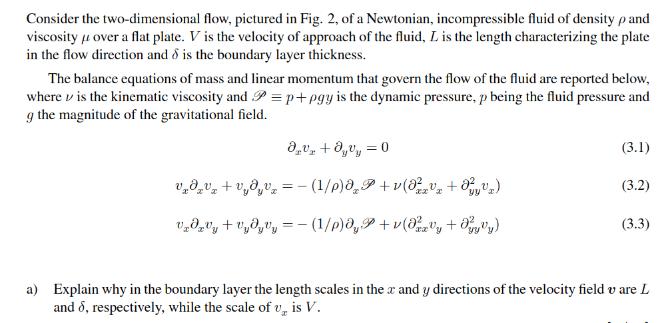Answered step by step
Verified Expert Solution
Question
1 Approved Answer
Consider the two-dimensional flow, pictured in Fig. 2, of a Newtonian, incompressible fluid of density p and viscosity over a flat plate. V is


Consider the two-dimensional flow, pictured in Fig. 2, of a Newtonian, incompressible fluid of density p and viscosity over a flat plate. V is the velocity of approach of the fluid, L is the length characterizing the plate in the flow direction and & is the boundary layer thickness. The balance equations of mass and linear momentum that govern the flow of the fluid are reported below, where is the kinematic viscosity and P = p+pgy is the dynamic pressure, p being the fluid pressure and g the magnitude of the gravitational field. +8=0 += (1/p) P+v(+82) == vy+y=- (1/p)P + v(x + y) (3.1) (3.2) (3.3) a) Explain why in the boundary layer the length scales in the x and y directions of the velocity field v are L and 5, respectively, while the scale of u is V. y v=Vex Boundary layer L x Figure 2: Sketch of the system. The z axis is normal to the sheet of paper. b) The value of 8(x) at a distance x from the leading edge of the flat plate is given by x/(Vx/v)1/2. Using this information, estimate the value of the shear stress exerted by the fluid on the flat plate at a distance x from its leading edge. Then, evaluate the drag force acting on the plate.
Step by Step Solution
There are 3 Steps involved in it
Step: 1

Get Instant Access to Expert-Tailored Solutions
See step-by-step solutions with expert insights and AI powered tools for academic success
Step: 2

Step: 3

Ace Your Homework with AI
Get the answers you need in no time with our AI-driven, step-by-step assistance
Get Started


